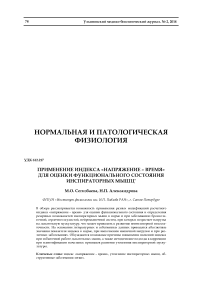Применение индекса «напряжение - время» для оценки функционального состояния инспираторных мышц
Автор: Сегизбаева Марина Оразовна, Александрова Нина Павловна
Журнал: Ульяновский медико-биологический журнал @medbio-ulsu
Рубрика: Нормальная и патологическая физиология
Статья в выпуске: 2, 2014 года.
Бесплатный доступ
В обзоре рассматривается возможность применения разных модификаций расчетного индекса «напряжение - время» для оценки функционального состояния и определения резервных возможностей инспираторных мышц в норме и при заболеваниях бронхолегочной, сердечно-сосудистой, нейромышечной систем, при которых возрастает нагрузка на дыхательную мускулатуру, что может приводить к развитию вентиляторной недостаточности. На основании литературных и собственных данных приводятся абсолютные значения показателя индекса в норме, при выполнении мышечной нагрузки и при различных заболеваниях. Обсуждаются возможные причины повышения значений индекса при избыточной работе дыхательных мышц, а также методические подходы к коррекции при идентификации начальных признаков развития утомления инспираторной мускулатуры.
Индекс "напряжение - время", утомление инспираторных мышц, обструктивные заболевания легких
Короткий адрес: https://sciup.org/14112992
IDR: 14112992
Список литературы Применение индекса «напряжение - время» для оценки функционального состояния инспираторных мышц
- Сегизбаева М. О. Оценка устойчивости разных групп инспираторных мышц к утомлению при физической нагрузке на фоне моделируемой обструкции дыхательных путей/М. О. Сегизбаева, Н. П. Александрова//Физиология человека. -2014. -Т. 40, № 5.
- A simple noninvasive pressure-time index at the mouth to measure respiratory load during acute exacerbation of COPD. A comparison with normal volunteers/C. Gonzalez [et al.]//Respir. Med. -2003. -Vol. 97, № 4. -P. 415-420.
- Inspiratory muscle activity during incremental exercise in obese men/M. Chlif [et al.]//Int. J. Obes (Lond.). -2007. -Vol. 31, № 9. -P. 1456-1463.
- Noninvasive measurement of the maximum relaxation rate of inspiratory muscles in patients with neuromuscular disorders/F. Garcia-Rio [et al.]//Respiration. -2006. -Vol. 73, № 4. -P. 474-480.
- Bellemare F. Effect of pressure and timing of contraction on human diaphragm fatigue/F. Bellemare, A. Grassino//J. Appl. Physiol. -1982. -Vol. 53, № 5. -P. 1190-1195.
- Bellemare F. Evaluation of human diaphragm fatigue/F. Bellemare, A. Grassino//J. Appl. Physiol. -1982. -Vol. 53, № 5. -P. 1196-1206.
- Determinants of the tension-time index of inspiratory muscles in children with cystic fibrosis/M. Hayot [et al.]//Pediatr. Pulmonol. -1997. -Vol. 23, № 5. -P. 336-343.
- Electromyographic validation of the mouth pressure-time index: a noninvasive assessment of inspiratory muscle load/J. P. deTorres [et al.]//Respir. Med. -2003. -Vol. 97, № 9. -P. 1006-1013.
- Gaultier C. Inspiratory force reserve of the respiratory muscles in children with chronic obstructive pulmonary diseases/C. Gaultier, M. Boule, F. Girard//Am. Rev. Respir. Dis. -1985. -Vol. 131. -P. 811-815.
- Milic-Emili J. Relationship between neuromuscular respiratory drive and ventilatory output/J. Milic-Emili, W. A. Zin//Handbook of Physiology. The Respiratory System. Mechanics of Breathing. -Bethesda, MD: Am. Physiol. Soc., 1986. -Sect 3. -Vol. III, pt 2. -P. 635-646.
- Noninvasive assessment of inspiratory muscle function during exercise/M. Hayot [et al.]//Am. J. Respir. Crit. Care Med. -2000. -Vol. 162, № 6. -P. 2201-2207.
- Non-invasive assessment of inspiratory muscle performance during exercise in patients with chronic heart failure/N. Vibarel [et al.]//Eur. Heart J. -1998. -Vol. 19, № 5. -P. 766-773.
- Noninvasive assessment of the tension-time index of the inspiratory muscles at rest in obese male subjects/M. Chlif [et al.]//Int. J. Obes (Lond.). -2005. -Vol. 29, № 12. -P. 1478-1483.
- Noninvasive determination of the tension-time index in Duchenne muscular dystrophy/A. Hahn [et al.]//Am. J. Phys. Med. Rehabil. -2009. -Vol. 88, № 4. -P. 322-327.
- Noninvasive measurement of the tension-time index in children with neuromuscular disease/L. T. Mulreany [et al.]//J. Appl. Physiol. -2003. -Vol. 95. -P. 931-937.
- Non-invasive tension-time index in relation to severity of disease/A. Hahn [et al.]//Pediatr Pulmonol. -2008. -Vol. 43, № 10. -P. 973-981.
- Prediction of exturbation outcome in infants using the tension-time index/A. Currie [et al.]//Archю Disю Fetal Neonatal Ed. -2011. -Vol. 96, № 4. -P. 265-269.
- Ramonatxo M. Validation of non-invasive tension-time index of respiratory muscles/M. Ramonatxo, P. Boulard, Ch. Prefaut//J. Appl. Physiol. -1995. -Vol. 78. -P. 646-653.
- Respiratory muscle deoxygenation during exercise in patients with heart failure demonstrated with near-infrared spectroscopy/D. Mancini [et al.]//J. Am. Coll Cardiol. -1991. -Vol. 18. -P. 492-498.
- Respiratory muscle function and dyspnea in patients with chronic heart failure/D. Mancini [et al.]//Circulation. -1992. -Vol. 86. -P. 909-918.
- Tension-time index of inspiratory muscles in COPD patients: role of airway obstruction/M. Hayot [et al.]//Respir. Med. -1998. -Vol. 92, № 6. -P. 828-835.
- The sensation of dyspnea during exercise is not determined by the work of breathing in patients with heart failure/D. M. Mancini [et al.]//J. Am. Coll Cardiol. -1996. -Vol. 28, № 2. -P. 391-395.
- Timing and driving components of the breathing strategy in children with cystic fibrosis during exercise/D. Keochkerian [et al.]//Pediatr. Pulmonol. -2005. -Vol. 40, № 5. -P. 449-456.
- Ventilatory muscles during exercise in air and oxygen in normal men/P. T. Bye [et al.]//J. Appl. Physiol. -1984. -Vol. 56, № 2. -P. 464-471.
- Whitelaw W. A. Airway occlusion pressure/W. A. Whitelaw, J. P. Derenne//J. Appl. Physiol. -1993. -Vol. 74. -P. 1475-483.


